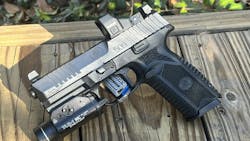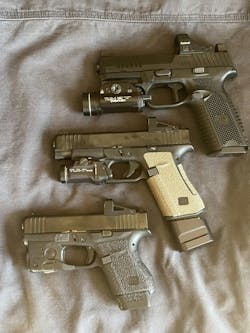Handgun as Weapon System: How to Keep It Working Smoothly
More on OFFICER.com
Download the March/April issue of OFFICER Magazine.
Click Here to subscribe to OFFICER Magazine.
Over 30 years ago, the United States Special Operations Command (USSOCOM) issued two contracts in pursuit of what was called the Offensive Handgun Weapon System. The handgun had to chamber the .45ACP cartridge, support use of a flash and sound suppressor and the attachment of a Laser Aiming Module (LAM). Ultimately, in 1996, Heckler & Koch with a specialized Model 23 won the contract and began delivering the first OHWS handguns. In the world of weapons, a lot has changed in the past 30 years. In today’s world nearly every contemporary handgun is being designed and built to accept a light and/or laser mounted under the dust cover, an optic on the slide and many of them have extended threaded barrels for attaching suppressors.
While there are plenty of off-duty officers and citizens carrying handguns chambered for .45ACP, there are probably a greater number carrying handguns chambered in 9mm with plenty more carrying guns in .40S&W, 10mm, .357Sig and probably a significant handful in .380ACP. What caliber the weapon is doesn’t have anything to do with whether or not it’s a “system.” Many would argue that no handgun carried by law enforcement or citizens is an “offensive” weapon, there may be an argument that they are sometimes used as such dependent on circumstance. The example used would be an officer responding to an active shooter situation. That officer makes entry into the scene, weapon up, following the sound of shots, searching for the “bad guy” target. He is using his weapon in an aggressive (offensive) fashion for defensive purposes. But I digress…
The intended use or motivation for use also does not have anything to do with whether or not it’s a weapon system. A handgun is just a handgun, right? Yes, but when you start mounting accessories on it and implement its use, even if just through daily carry, with those accessories as part of the weapon, then it has become a “system.” Training, policy, maintenance and more no longer revolves around the weapon only but also has to take into consideration and cover each accessory.
In a great many duty holsters today there is the issued or approved handgun with a flashlight mounted on a picatinny rail under the dust cover and, in growing numbers, a red dot optic on the slide behind the ejection port in front of the rear sight. It’s interesting to note that the use of the Red Dot Sight (RDS) often is accompanied by taller front and rear mechanical sights so that if the RDS battery dies or the optic fails in another way, the hard sights can still be used; the shooter can co-witness through the optic. What’s interesting is that those higher sights would also be required if a suppressor was mounted on the weapon, but many agencies specifically don’t call them “suppressor height sights,” believing that sounds “too militaristic” or aggressive. They call them “optic friendly” or simply “high sights.”
What’s the difference to the officer if they are carrying a handgun weapon system? Put simply, they have to do everything with each accessory that they would normally do with the handgun, plus battery management. Each officer is required to qualify with their duty (and often off-duty) handgun. If a RDS is mounted and used, the officer should be required to qualify using that RDS as the primary sighting system but also with the RDS turned off, using the hard sights instead. Prior to use for qualification, the RDS has to be properly mounted and zeroed, both of which should be done by the agency armorer staff.
If the weapon has a mounted flashlight, the officer should qualify with it in place but not being used (such as normal day qualification) but then also with the light used for low-light engagements AND without using the mounted light but instead using a handheld light for low-light engagements, simulating the circumstance of the mounted flashlight being damaged or having dead batteries.
After practicing or qualifying, just like the handgun needs to be cleaned, so does the flashlight and so does the optic. The additional maintenance requirements are checking the mounting systems for security/tightness and making sure that each accessory has good batteries. If the optic has to be removed to replace the batteries, or if the mounting screws have been loosened at all, it needs to be rezeroed before being trusted on duty.
Make no mistake, carrying a handgun weapon system requires more work for maintenance, more policy and protocols for carry and use and more training time, more ammo, etc. Some agencies don’t increase the training regimen when they authorize the addition of a flashlight or optic. They merely train to use them but rarely, if ever, train for failure of either. The maintenance of the accessories is also often left to the officer on whose weapon they’re mounted, without training or specific policy. Agencies need to recognize the potential liability of neglecting proper policy and training covering all aspects of not only the handgun, but the accessories authorized for attachment thereto.
For those officers reading this, remember that your handgun, with accessories attached, isn’t just the weapon: It’s a system of combined tools that increase your capabilities IF you follow all necessary protocols, safe practices and train properly.
About the Author
Lt. Frank Borelli (ret), Editorial Director
Editorial Director
Lt. Frank Borelli is the Editorial Director for the Officer Media Group. Frank brings 20+ years of writing and editing experience in addition to 40 years of law enforcement operations, administration and training experience to the team.
Frank has had numerous books published which are available on Amazon.com, BarnesAndNoble.com, and other major retail outlets.
If you have any comments or questions, you can contact him via email at [email protected].


